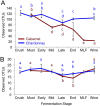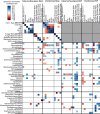Associations among Wine Grape Microbiome, Metabolome, and Fermentation Behavior Suggest Microbial Contribution to Regional Wine Characteristics
- PMID: 27302757
- PMCID: PMC4959672
- DOI: 10.1128/mBio.00631-16
Associations among Wine Grape Microbiome, Metabolome, and Fermentation Behavior Suggest Microbial Contribution to Regional Wine Characteristics
Abstract
Regionally distinct wine characteristics (terroir) are an important aspect of wine production and consumer appreciation. Microbial activity is an integral part of wine production, and grape and wine microbiota present regionally defined patterns associated with vineyard and climatic conditions, but the degree to which these microbial patterns associate with the chemical composition of wine is unclear. Through a longitudinal survey of over 200 commercial wine fermentations, we demonstrate that both grape microbiota and wine metabolite profiles distinguish viticultural area designations and individual vineyards within Napa and Sonoma Counties, California. Associations among wine microbiota and fermentation characteristics suggest new links between microbiota, fermentation performance, and wine properties. The bacterial and fungal consortia of wine fermentations, composed from vineyard and winery sources, correlate with the chemical composition of the finished wines and predict metabolite abundances in finished wines using machine learning models. The use of postharvest microbiota as an early predictor of wine chemical composition is unprecedented and potentially poses a new paradigm for quality control of agricultural products. These findings add further evidence that microbial activity is associated with wine terroir
Importance: Wine production is a multi-billion-dollar global industry for which microbial control and wine chemical composition are crucial aspects of quality. Terroir is an important feature of consumer appreciation and wine culture, but the many factors that contribute to terroir are nebulous. We show that grape and wine microbiota exhibit regional patterns that correlate with wine chemical composition, suggesting that the grape microbiome may influence terroir In addition to enriching our understanding of how growing region and wine properties interact, this may provide further economic incentive for agricultural and enological practices that maintain regional microbial biodiversity.
Copyright © 2016 Bokulich et al.
Figures







References
-
- Fischer U, Roth D, Christmann M. 1999. The impact of geographic origin, vintage, and wine estate on sensory properties of Vitis vinifera cv. Riesling wines. Food Qual Preference 10:281–288. doi:10.1016/S0950-3293(99)00008-7. - DOI
-
- Robinson AL, Adams DO, Boss PK, Heymann H, Solomon PS, Trengove RD. 2012. Influence of geographic origin on the sensory characteristics and wine composition of Vitis vinifera cv. Cabernet sauvignon wines from Australia. Am J Enol Vitic 63:467–476. doi:10.5344/ajev.2012.12023. - DOI
Publication types
MeSH terms
Grants and funding
LinkOut - more resources
Full Text Sources
Other Literature Sources
Medical
Molecular Biology Databases
Miscellaneous

